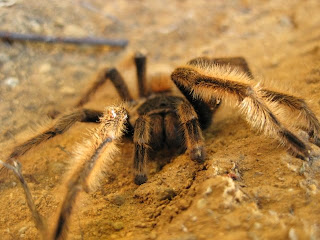
The main wilderness draw of Pucón is Volcán Villarica. We were told we absolutely had to buy the tour and make the ascent. Maybe that is why we didn´t do it. It was also quite expensive. We decided that what we really wanted to do was to see some araucaria trees and then start heading north so we would have some time in the north of Argentina and in Bolivia before we meet up with my parents in Perú.
To save time we decide to do the "fast-hiker's" version of a 4 day trek through Parque Nacional Huerquehue in two days. The days were long but everything went fine. The hardest part was on the second day leaving the campsite at Las Termas Ecologico, a campsite with wonderful semideveloped hot springs located on the Río Blanco. It was a heavenly place run by nice people with cheap beer.

The walk had some nice lakes, waterfalls and views across to Villarica. There were some more interesting small animals. We saw a giant moth (you missed it Mike!), a tarantula, some hares, millions of lizards, and a baby bird.







The star of the show, however, was the araucaria tree, also called the monkey puzzle. It is a stange tree without leaves in the normal sense. Instead its branches are ensconced in bright green spikey leaf-like scales that form starburst patterns at the tips. The trees are very different from each other depending on their size. The giant ones have long bare trunks with explosions of branches at the top and sometimes a few other profusions a little lower down, similar in some respects to the coastal redwood of California. The medium sized trees often have the look of the platonic ideal of a Christmas tree. I found the small ones the most wonderful, however. They have long branches twisting out at surprising angles taking on the forms and gestures of frozen dancers. In this respect they remind me of Joshua trees, the leafless foxtail pines of the high Sierra, or even the elms of Central Park in winter, not because they are similar biologically, but because they have such expressiveness in their forms. It is almost as if they are trying to say something.










Now we are in San Martín de los Andes staying with Federico Ocampo brother of Silvina. Federico es muy amable and he took us walking along a beautiful lake.



No comments:
Post a Comment